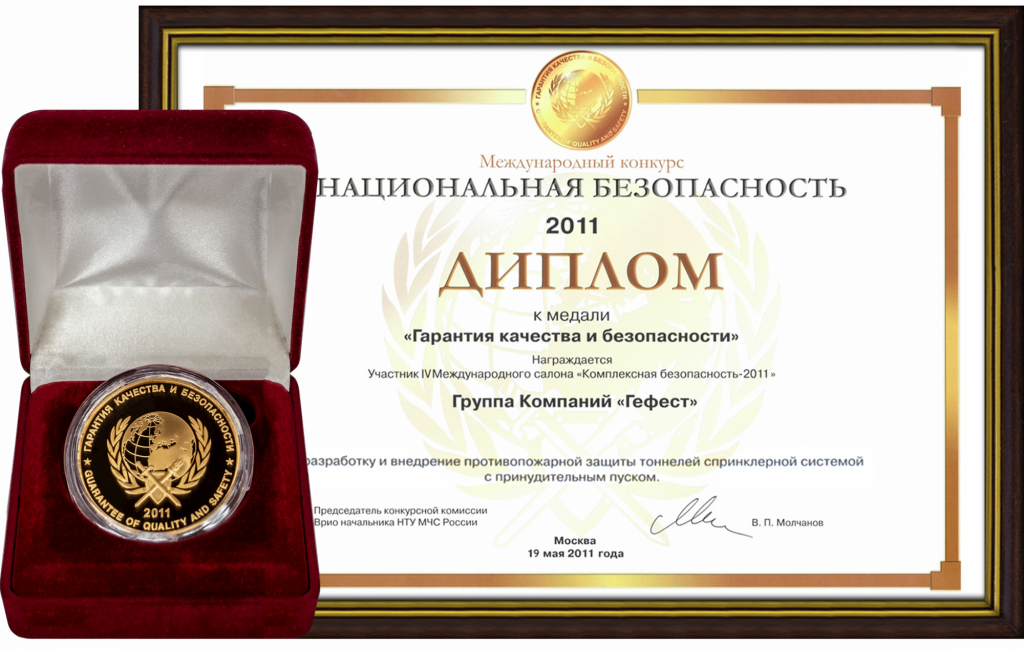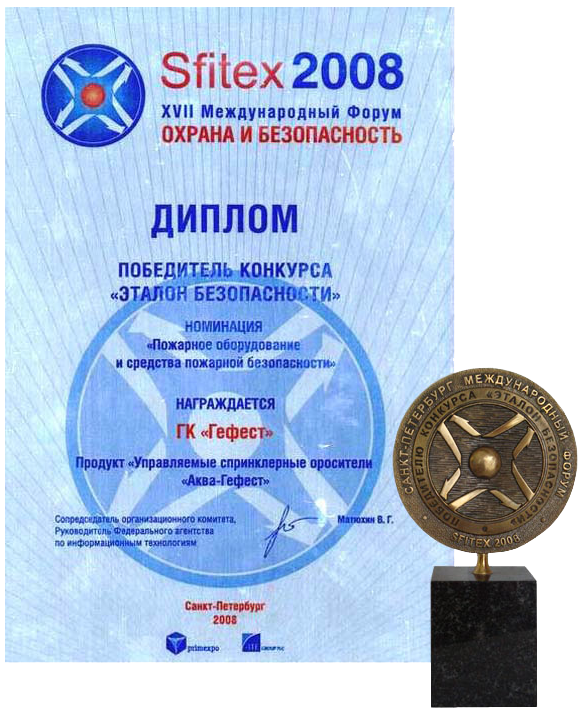Automatic fire extinguishing installation with electrical activation
General level of fire automation development has been changed dramatically in recent decades. Due to implementation of microprocessors and invention of new types of sensors early fire detection means has been modernized and a possibility of programmable implementation of algorithms of fire-safety systems has become available.
Basing on modern engineering technical solutions, specialists of “Gefest” Enterprise group has developed a unique sprinkler extinguishing system with electrical activation (EAS-S), which considerably increased extinguishing efficiency.
Devices of automatic fire extinguishing unit with electrical activation
- Programmable complex of technical devices “Olimp”, which implements programmable control of fire extinguishing installations- Commutation and diagnostics device UK-D(06), which is used for group sprinkler activation
- Sprinklers with electrical activation “Aqua-Gefest”. Their remote activation can be implemented manually or automatically according to a pre-set algorithm. Control is provided by “Olimp” system or UK-D 06.
-Satellite fire detectors. This device is used for detection of ignition and supply of starting current to a heating element of a sprinkler with electrical activation. Satellite fire detector is connected with the sprinkler via a matching device, which provides activation without extra processing of signals on a control panel. So, after the actuation of the fire detector, corresponded sprinklers near to a fire source are activated as well.
Distinctive features
Traditional sprinkler systems are the most common automatic fire extinguishing means. Design of modern sprinklers has not been changed for years and represents a shut-off valve with a heat lock and deflector, forming needed sprinkler map. Temperature rises right after fire breaking-out, which leads to opening of the heat lock and beginning of extinguishing. However, failure or delay of heat lock actuation in some cases is possible, for example in compartments with high ceilings, as it takes a long time for temperature to be enough for activation of sprinklers.
The difference of automatic fire extinguishing installations with electrical activation from the traditional ones is that sprinklers are activated regardless the temperature in their installation zone. Technology of electrical activation makes it possible to activate sprinklers via current and also traditionally. Such technology provides effective use of sprinklers and reduces extinguishing time.
Activation can be caused by a signal from a fire detector included in fire alarm, address signal from the first activated sprinkler or by any other device included in the system and programmed for sending signal about the fire.
Principle of operation
Specialists of “Gefest” Enterprise group introduced changes to sprinkler design for implementation of electrical activation implementation. Now sprinklers can be activated via a pre-programmed algorithm and their condition can be visualized on the screen.
The main element of the sprinkler with electrical activation is a heater installed on the bulb. It heats the bulb and it is destructed. Sprinklers also can have devices, which provide monitoring of activation (formation of signal about their activation). Satellite fire detectors (accelerators of activation) can be also implemented if necessary. They provide sprinkler activation right after fire detection.
Activation algorithms
Both individual sprinklers and their groups can be activated in EAS-S.
- Individual activation. It is used for provision of accelerated sprinkler activation in compartments where sprinklers may be activated late or may not be activated at all (e.g. in compartments with high ceilings and high fire spread speed). In such algorithm satellite fire detectors are used as activation accelerators. Sprinkler nearest to a fire source is activated automatically after the activation of the detector. For increase of operation reliability it is recommended to foresee a possibility of enable signal for sprinkler activation by “Fire” signal from the fire alarm. Such algorithm can be implemented via “Olimp” system. Morе.
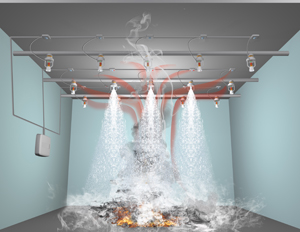 |
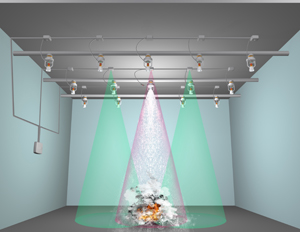 |
|
Individual sprinkler activation by detection of satellite differential detectors
|
Individual sprinkler activation by detection of fire detectors
|
Group non-programmed activation. An activation group is formed strictly connected to an exact place on the object. The start of this group can be practiced via fire automation devices or satellite fire detectors. The activation of the group blocks further spreading of the fire. Implementation of group non-programmed activation can be used for creating water screens, limiting possible fire-spreading, protection of technical equipment, protection of door openings and bails made from glass. For example there is the actuation of a sprinkler group in a building, where the fire is detected by an address automatic fire alarm.
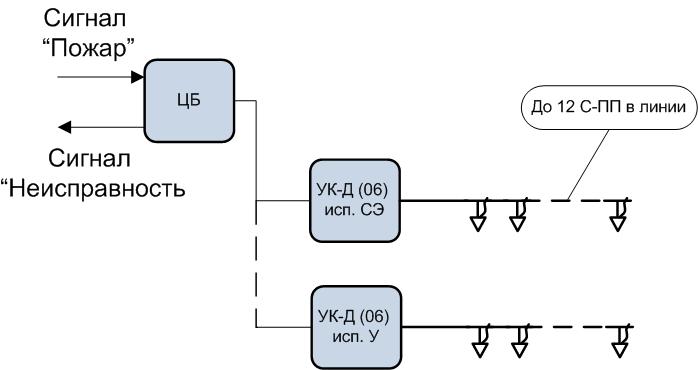
For implementation of group non-programmed start FCU “Gefest” is used. It consists of UKLSIP(RP) or UCSC (B), UKD(06) SE. Recommended diagrams of powering of controlled sprinklers in groups are represented on figures.
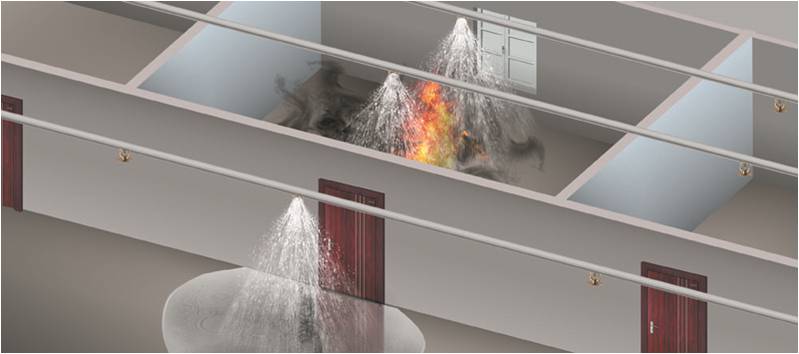
Group programmed start – Activation group is formed automatically around the hotbed axis, thereby increasing the area sprinkled by sprayers and localizing the hotbed before its further spreading. It is shown on the figure how 8 sprinklers, located around the actuated one, were simultaneously opened, thus, the hotbed was localized from all sides.
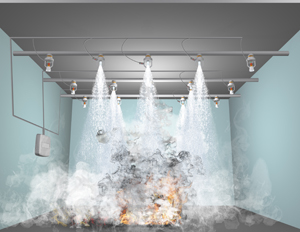
For implementation of group programmed activation a complex of technical devices “Olimp” is used. It allows implementing nearly any activation algorithm of sprinklers and practicing modern address system on the basis of water extinguishing unit where:
- Every sprinkler gets its own address
- Sprinkler mode is always under control
- Within regular reaction of any sprinkler or satellite flame detector its address is defined and sprinkles (sprayers) are activated according to given program by force.
- Activation of electrical circuit to every sprinkler as well as all electrical circuits are monitored in a case of short current or fault
- Troubled incidents can be registered in electric-dependent memory
Advantages:
- Providing of guaranteed extinguishing via actuating of several sprinklers on the area that is knowingly larger than the hotbed area;
- Limiting of the fire area via actuation of sprinklers on the way of possible fire spreading
- Monitoring of water screens activation
- Protecting of buildings of 30 m. height
- Accurate detection of a fire location (using sprinklers with electrical activation and monitoring of activation)
Application area:
EAS are recommended to be used during the protection via automatic water extinguishing units of following locations:
· With high fire danger, including high-shelf storages, cable and transport tunnels, automation parking lots, etc…
· With big quantity of people
· High-rise buildings
· With big quantity of physical things
· With great historical, cultural or social meaning
Other locations relating to socially important or unique and also for compensation of following digressions from present normative requirements:
- Exceeding of the normative area of the fire module
- Exceeding of the permitted height of storage
- Difficult access to the possible fire zone for fire brigades
- Exceeding of the normative height of the building
- Fireproof limit decrease of building structures, including translucent compartments in relation to normative one.
- Presence of atrium spaces
- Fireproof rate decrease of the building in relation to the normative one.
- Placement of groups of buildings with different functional fire danger in the area of one fire module
- Exceeding of the normative length of evacuation paths
- Exceeding of the normative distance from the fire department to the protected location (At that, the time devoted to the installation must not be less than the time needed by fire brigades to come to the location.
 Certificate of Conformity to TR EEU for Olimp-I system.pdf
Certificate of Conformity to TR EEU for Olimp-I system.pdf 
